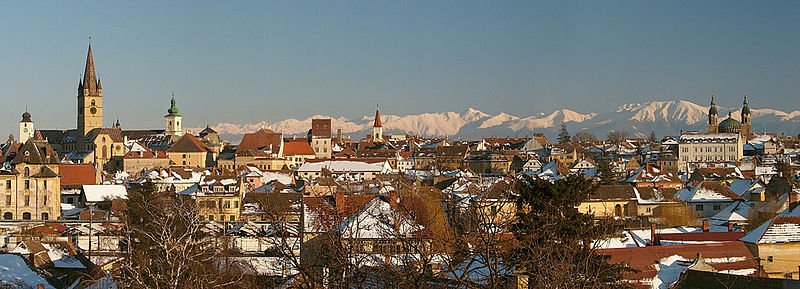 Sibiu, Romania
Sibiu, RomaniaSource: https://en.wikipedia.org/wiki/File:Panoramic-Sibiu.jpg
Author: Mastermindsro, CamilG

Sibiu is a city straddling the Cibin River in central Romania. The city which served as the capital of the Principality of Transylvania from 1692 to 1791 is today the capital of Sibiu County. It covers 121 sq km (46.7 sq mi) and has a population of 155,000 people (2011 estimate). The city was the European Capital of Culture in 2007, along with Luxembourg City.
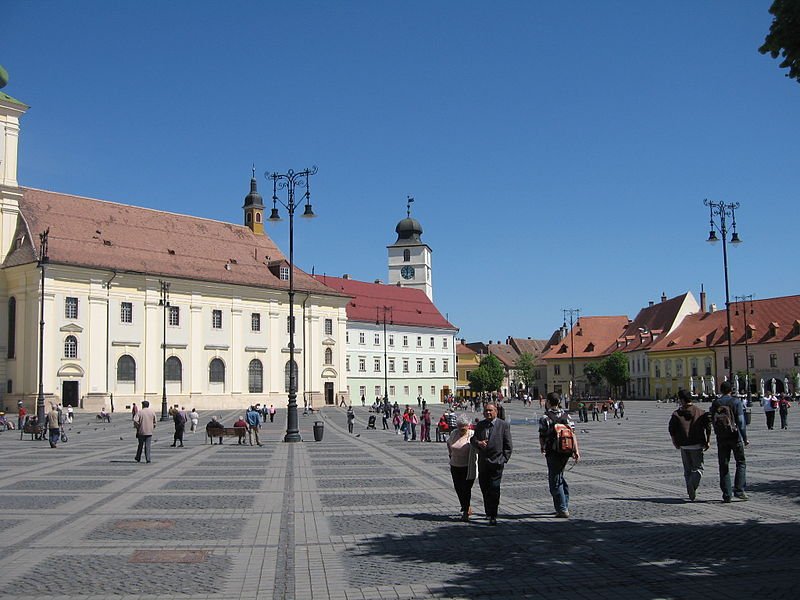 Grand Square, Sibiu
Grand Square, SibiuSource: https://commons.wikimedia.org/wiki/File:Piata_Mare_din_Sibiu6.jpg
Author: Cezar Suceveanu

Sibiu is situated in the Cibin Depression, about 282 km northwest of Bucharest. It experiences a temperate continental climate. July is the warmest month here, with average temperature ofc 19.9°C. January is the coldest month, when average temperature drops to -4°C. June receives the most rain, at 118 mm.
The city of Sibiu dates back to AD 1191, when Pope Celestine III confirmed its existence. It grew to become an important trading center by the 14th century. German settlers arrived to populate it and the surrounding areas. They called the city Siebenbürgen, meaning seven cities.
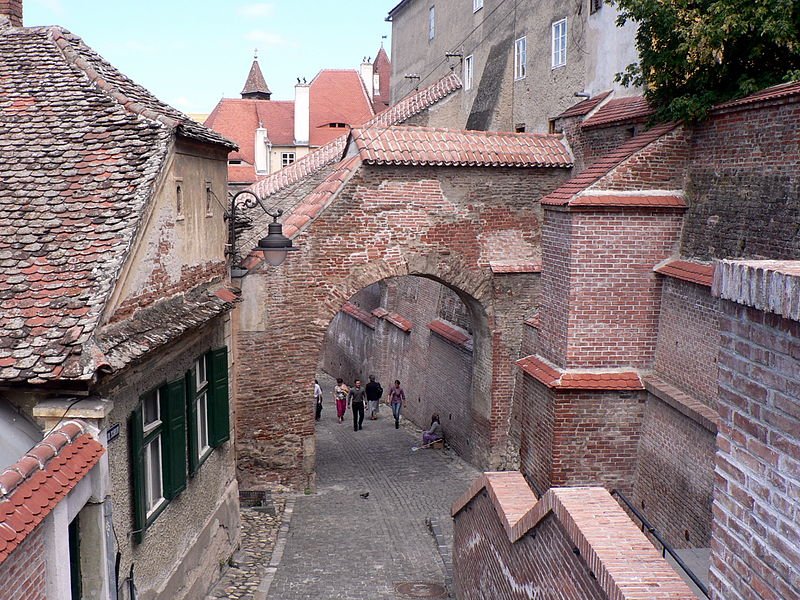 Passage of the Stairs, Sibiu
Passage of the Stairs, SibiuSource: https://commons.wikimedia.org/wiki/File:Sibiu,_street_and_walls.jpg
Author: Krzysztof Dudzik
 In the 1860s, Sibiu became the Metropolitan seat of the Romanian Orthodox Church, and is still today one of the important centers of the faith. It was part of Transylvania, which was in turn ruled by the Habsburg Empire until its dissolution following World War I, after which Sibiu and Transylvania became part of Romania.
In the 1860s, Sibiu became the Metropolitan seat of the Romanian Orthodox Church, and is still today one of the important centers of the faith. It was part of Transylvania, which was in turn ruled by the Habsburg Empire until its dissolution following World War I, after which Sibiu and Transylvania became part of Romania.
Visiting Sibiu
Sibiu International Airport (SBZ) receives flights from Antalya, Bucharest, Doha, Dubai, Hurghada, Munich, Timişoara and Vienna, among others. You can also get there by train from Brasov and Cluj-Napoca.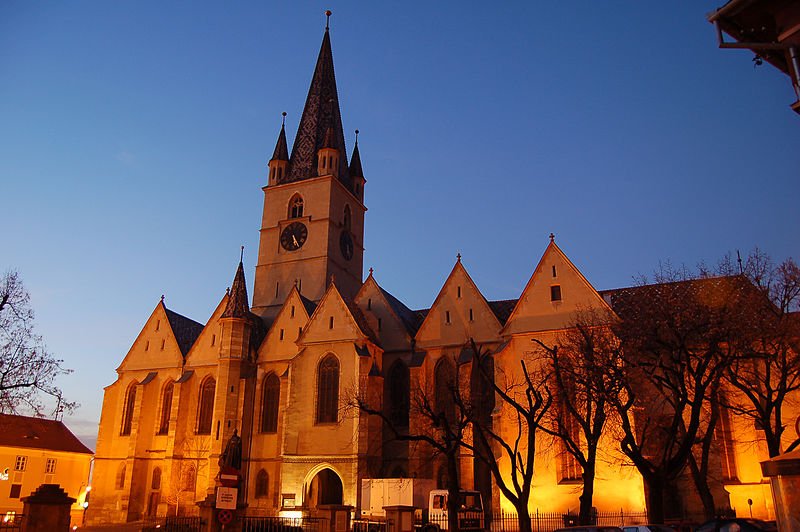 Evangelical Church of Sibiu
Evangelical Church of SibiuSource: https://commons.wikimedia.org/wiki/File:Biserica_evanghelica_vedere_fata-sibiu.jpg
Author: HoriaStan

Sections of Old Sibiu
- Lower Town
Neighborhood of Sibiu betweent he river and the hill. Traditionally the manufacturing part of town, it has a number of historic buildings from the medieval period. - Upper Town
This is the wealthier, commercial part of Old Sibiu.
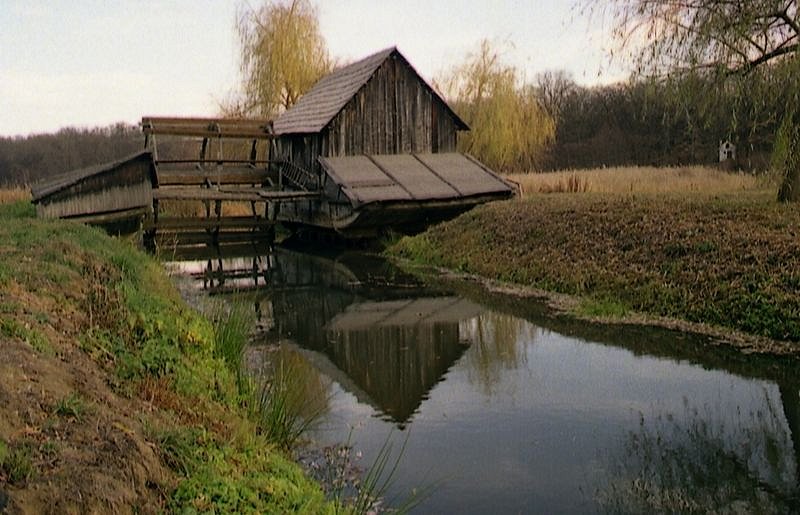 Watermill at the Traditional Folk Civilization Museum, Sibiu
Watermill at the Traditional Folk Civilization Museum, SibiuSource: https://commons.wikimedia.org/wiki/File:Muzeul_satului_sibiu_2.JPG
Author: Qyd

Sights & Attractions in Sibiu
- ASTRA National Museum Complex
This is a group of ethnography museums that include the Traditional Folk Civilization Museum, the Universal Ethnography Msueum, the Msueum of Transylvanian Civilization and the Museum of Saxon Ethnography and Folk Art. To be added to it is the Museum of the Culture and Civilization of the Romany People. - Brukenthal National Museum
Museum housed in the Brukenthal Palace in the Grand Square. Opened in 1817, it is the oldest museum in Romania. - Grand Square (Piaţa Mare)
The biggest public square in Sibiu and one of the largest in Transylvania, it is surrounded by many historic buildings including the Brukenthal Palace and Jesuit Church. - Huet Square
Public square with a number of attractions, mainly historic buildings in the Gothic architectural style, including the Evangelical Lutheran Cathedral. - Jesuit Church
Church within part of the former Jesuit complex in Sibiu. - Lesser Square (Piaţă Mică)
The smaller of the two major public squares in Sibiu. - Passage of the Stairs
A highly photogenic section of old town, with stairs leading from the lower to the upper part of Sibiu. - Sibiu Citadel
Medieval fortifications of the city. Although the exterior fortifications have been torn down to make way for industrial development in the late 19th century, the inner fortifications and towers still stand today. - Steam Locomotives Museum
Museum showcasing some 40 locomotives, located near the railway station.
 Latest updates on Penang Travel Tips
Latest updates on Penang Travel Tips

Copyright © 2003-2025 Timothy Tye. All Rights Reserved.

 Go Back
Go Back